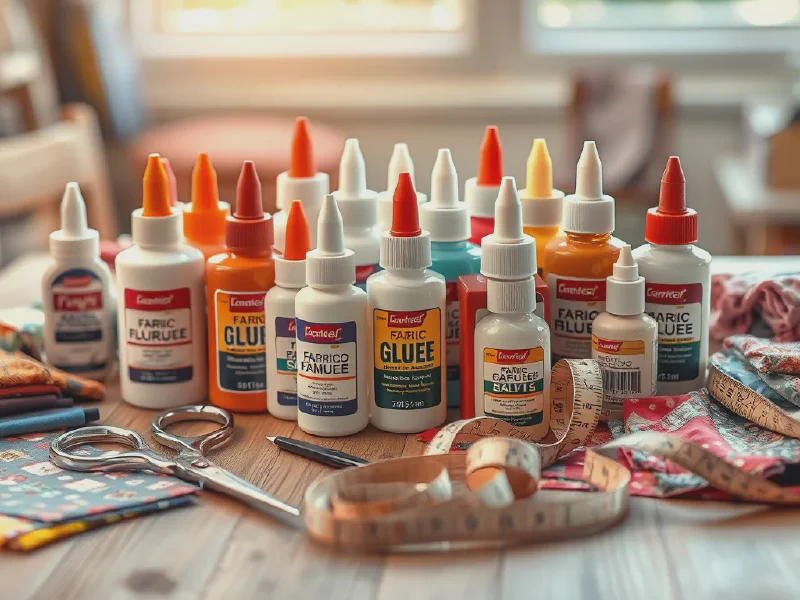What is the Best Fabric Glue? : Permanent Adhesives for Sewing, Crafting, and Costume Bonding – Reviews, Alternatives, and Uses for Cloth, Foam, Plastic, Wood, and More

The best fabric glue is Beacon Fabri-Tac, a permanent adhesive that creates strong, flexible, and washable bonds between fabrics (offering superior durability and versatility for most fabric types); alternative top options include Tear Mender for waterproof applications and Gorilla Fabric Glue for heavy-duty projects.
Permanent fabric adhesives create the strongest bonds for fabric applications. Beacon Fabri-Tac leads the market with industrial-strength adhesion that maintains flexibility after drying. The adhesive penetrates fabric fibers to create permanent molecular bonds.
Fabric glue properties determine optimal usage scenarios. Water-resistant formulations withstand multiple wash cycles without degradation. Quick-dry options set within 2-3 minutes for immediate hold. Flexible formulas allow natural fabric movement without cracking or peeling.
Application requirements impact glue selection significantly. Precision tips enable detailed work on small areas and edges. Spray adhesives provide even coverage for large surfaces. Brush-on formulas allow controlled application for medium-sized projects.
Safety considerations guide fabric glue choices. Non-toxic formulations prevent skin irritation during application. Low-VOC options minimize harmful fume exposure. Water-based adhesives enable easy cleanup with soap and water.
Fabric glue selection requires matching adhesive properties to project needs. The best fabric glue provides permanent bonds, maintains flexibility, resists washing, and applies easily. Beacon Fabri-Tac meets these key requirements for most applications. Alternative options serve specialized needs for waterproof repairs or heavy-duty materials.
Best Fabric Glues in 2025
- Beacon Fabri-Tac - Best Overall Fabric Glue for Crafting
- Tear Mender Fabric Glue - Best Waterproof Fabric Adhesive
- Gorilla Fabric Glue - Best Heavy-Duty Fabric Adhesive
- Speed-Sew Fabric Glue - Best Quick-Fix Fabric Repair Solution
Beacon Fabri-Tac: Best Overall Fabric Glue for Crafting
Beacon Fabri-Tac is a permanent fabric adhesive that creates strong, flexible, and washable bonds between fabrics and various materials like lace, leather, wood, and vinyl.
Pros:
- Crystal-clear finish when dry
- Quick-drying formula with precise applicator tip
- Maintains flexibility after drying
- Machine washable
- Doesn't bleed through materials
Cons:
- Flammable - must store away from heat
- Can thicken over time when stored
- Applicator tip may clog with extended use
Best for: Detail work, embellishments, mixed media crafting, and projects where a clear finish is critical. The best fabric glue for costume designers and crafters working with decorative elements.
Tear Mender Fabric Glue: Best Waterproof Fabric Adhesive
Tear Mender is a natural latex-based adhesive that creates permanent, waterproof bonds on fabrics and porous materials, ideal for items exposed to moisture.
Pros:
- Environmentally friendly with natural rubber latex compounds
- Waterproof and UV-resistant
- Machine washable and dry-cleanable
- Forms flexible bonds in minutes
- Made in USA
Cons:
- Initial ammonia odor (dissipates after curing)
- May cause reactions for those with latex allergies
- Dries to a slightly off-white color
Best for: Outdoor fabric items, canvas repairs, and heavy-duty applications. The best fabric glue for repairing items that will be exposed to weather or frequent washing.
Gorilla Fabric Glue: Best Heavy-Duty Fabric Adhesive
Gorilla Fabric Glue is a permanent adhesive designed for tough fabric projects and repairs that require exceptional strength and durability across multiple surfaces.
Pros:
- Industrial-strength bonding capability
- Waterproof and machine washable
- Works on multiple surfaces beyond fabric
- Dries clear with flexible finish
- Weather-resistant for outdoor applications
Cons:
- Longer drying time than some competitors
- Can be difficult to remove if misapplied
- Thicker consistency may be challenging for delicate fabrics
Best for: Upholstery repairs, heavy fabrics, and projects where maximum durability is essential. The best fabric glue when you need industrial-strength bonds that will last for years.
Speed-Sew Fabric Glue: Best Quick-Fix Fabric Repair Solution
Speed-Sew is a latex-based adhesive designed for quick fabric repairs and no-sew applications on materials including denim, leather, and general textiles.
Pros:
- Quick-drying adhesion
- Flexible bonds that don't crack
- Durable through washing cycles
- Works well on heavy fabrics
Cons:
- May leave white residue, especially on light-colored fabrics
- Distinct odor during application and curing
- Bonding strength varies by fabric type
Best for: Emergency repairs, simple hems, and projects requiring a quick turnaround. The best fabric glue for on-the-spot fixes when sewing isn't practical.